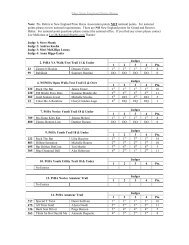2011 Official Rule Book - New England Pinto Horse Association
2011 Official Rule Book - New England Pinto Horse Association
2011 Official Rule Book - New England Pinto Horse Association
Create successful ePaper yourself
Turn your PDF publications into a flip-book with our unique Google optimized e-Paper software.
ClassEs<br />
126 <strong>2011</strong> PtHA <strong>Rule</strong> <strong>Book</strong><br />
b. Division B.<br />
(1) Side-pass. An object of such nature and length,<br />
which is safe may be used to demonstrate the<br />
responsiveness of the horse to signals at its side.<br />
If raised, height may not exceed two (2) feet. The<br />
obstacle should be designed to require the horse<br />
to side pass, to the right or left, off pressure or<br />
signal, on or near its side. The obstacle should be<br />
in the course design such that the horse comes<br />
up to it, but does not cross or straddle it while<br />
completing the side pass. The exhibitor is allowed<br />
to touch the horse on the side during the side<br />
pass.<br />
(2) Lime Circle. Requiring either:<br />
(a) Turn on the forehand with front feet inside<br />
and back feet turning outside the circle. The<br />
handler may hold the horse and the excess<br />
lead in his/her left hand during the turn.<br />
(b) Turn on the haunches with hind feet inside<br />
and front feet turning outside the circle.<br />
(3) Square, minimum eight (8) feet sides. Lead into<br />
the square. While all four (4) feet are confined in<br />
the square, make a 360 degree or less turn and<br />
lead out. Handler’s feet should remain in square<br />
also.<br />
(4) Gate. The gate must be set up so that it is a<br />
minimum of four (4) feet in length and four (4)<br />
feet in height and so that the exhibitor can open<br />
from his/her left side. It is permissible to carry<br />
excess lead in the right hand while negotiating<br />
the gate. Handlers losing control of the gate while<br />
passing through shall be penalized and scored<br />
accordingly.<br />
c. Division C.<br />
(1) Back through. Shall consist of either:<br />
(a) Poles. Straight L, double L, V, U or similar<br />
shaped obstacle. Poles should be on the<br />
ground, thirty (30) inches between minimum.<br />
Handler may remain outside or inside the<br />
poles.<br />
(b) Barrels or Cones, minimum of three. Thirtysix<br />
(36) inches between minimum. Handler<br />
and horse can pass between barrels or<br />
cones together.<br />
(c) Triangle. Thirty-six (36) inches between<br />
minimum at entry and forty (40) inches<br />
between minimum for sides. Note: If<br />
guardrails are used with b. or c. above, they<br />
shall be three (3) to four (4) feet from the<br />
sides of the obstacle.<br />
(2) Bridge. A bridge with a wooden floor not to<br />
exceed twelve (12) inches in height and with or<br />
without side rails not less than forty-eight (48)<br />
inches apart will be used.<br />
(3) Water Hazard. A ditch or shallow pond of water<br />
may be used. A horse must pass through this<br />
obstacle, which must be large enough so that to<br />
properly complete this obstacle all four (4) feet of<br />
the horse must step in the water. Management<br />
may not place any item in the water. If a box is<br />
used, simulated water is permissible. If water is<br />
used, handler should walk to left of water while<br />
horse passes through water.



